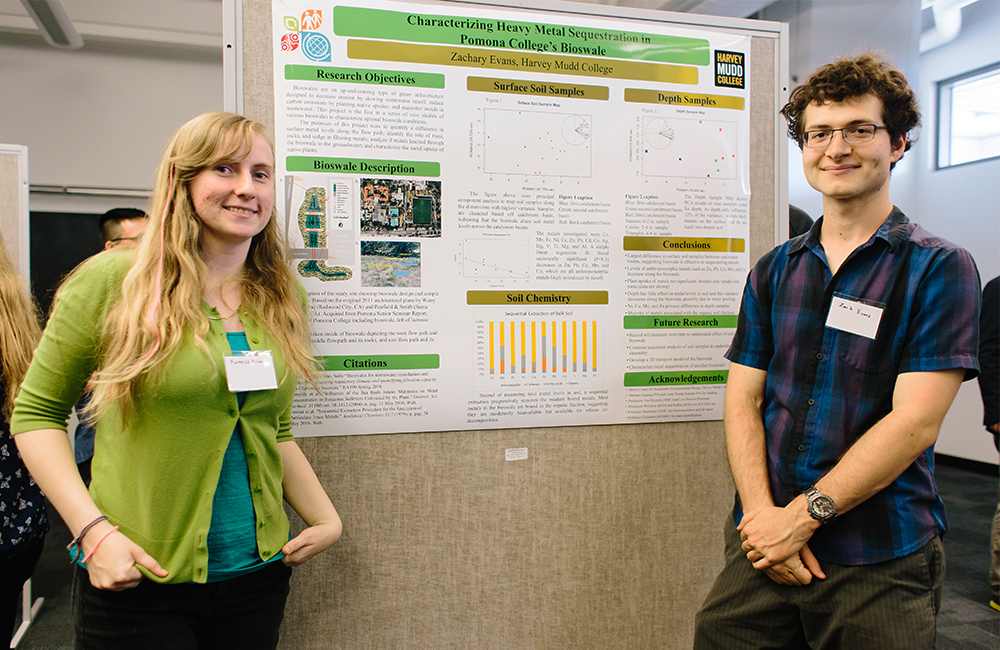Evans’ ILLiad Odyssey
May 2, 2017
When Zach Evans ’18 set out to find a summer research project, he wound up in a ditch. Don’t worry, he’s fine. In fact, not only is the ditch (a bioswale at Pomona College, to be specific) a perfect location for his research, but his journey to determine his career path earned Evans an Undergraduate Research Award from The Claremont Colleges Library.
The Claremont Colleges Library Undergraduate Research Awards honor students who demonstrate exemplary original research and scholarship, including remarkable skill and creativity in the use of library and information resources. Each winner receives a $500 cash prize.
Evans, a chemistry major studying metal remediation and a co-president of ESW/MOSS, was curious about the subject of biogeochemistry. He sought to develop a project that would help him decide if a career in this field would allow him to combine his passion for environmental issues with chemistry research. When he realized that the undergraduate Claremont colleges lacked a professor whose focus was biogeochemistry, Evans turned to the Rasmussen Research Fund for support and to the library for information.
Evans’ literature search began with a bit of a disappointment. Initially, he sought to study iron cycling in a model lagoon but learned that iron in that pH environment precipitates beyond conventional limits of detection. Back to the stacks, Evans set out to find a better medium in which to look at metal remediation and discovered an active area of research concerning the fate of metals during the composting process. “I extensively searched for literature explaining the science behind composting to design my research project,” says Evans, “but during the first week of that research, I discovered that this project wasn’t logistically feasible due to the length of time composting takes.”
The opportunity to use the bioswale as a field laboratory was presented by Hixon Professor of Sustainable Environmental Design Tajna Srebotnjak, who was excited to hear of Evans’ research. “I got interested in bioswales as part of a project idea several faculty members and I developed in the fall of 2015 for the South Coast Air Quality Management District,” Srebotnjak says. “Zach was active with ESW/MOSS and, as a chemistry major, his interests were moving toward metal cycling in wetlands. So it was an obvious fit.”
Advised by chemistry Professor Hal Van Ryswyk, environmental analysis Professor Marc Los Huertos (POM) and Srebotnjak, Evans began studying the fate of metals after they are introduced into the bioswale, for example, how tightly they bind to soil, how far they infiltrate and how effectively they are absorbed by native plants. Because he and his advisors lacked experience in asking those questions, Evans went back to the library to scour various journals for the methodologies, results and limitations of relevant techniques.
“For my summer research, I relied upon literature I found using the library’s databases and the feedback of my advisors to generate my project, shape my research questions and design my experimental procedures,” Evans says. “I could not have done this project without access to the journals provided by the library, the ability to acquire papers through ILLiad and access to ArcMap in the library’s Digital Toolshed.”
It was fellow ESW/MOSS co-president Kareesa Kron ’18 who suggested Evans submit his work for the research award. “She said, ‘You always run off to the library; you should apply for this.’ So I did,” says Evans. In addition to the library award, Evans received Outstanding Presentation honors at the recent ACS National Conference for his poster, “Spatial Distribution of Sequestered Metals in an Arid Southern California Bioswale,” the result of his work in the library.
